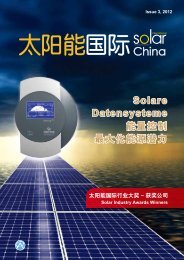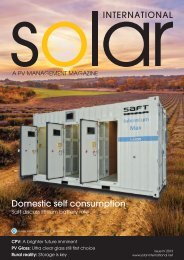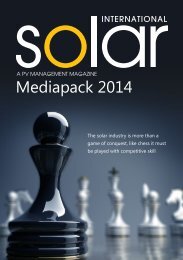A clearer road ahead
A clearer road ahead - Solar International Magazine
A clearer road ahead - Solar International Magazine
- No tags were found...
You also want an ePaper? Increase the reach of your titles
YUMPU automatically turns print PDFs into web optimized ePapers that Google loves.
YIELD I TESTING<br />
Figure 5: Red features<br />
are voids in the solder<br />
joining the metal heat<br />
sink to the underside of<br />
a concentrator cell<br />
The numerous large and small features are voids<br />
in the adhesive. Like delaminations, they block<br />
heat flow and cause overheating.<br />
In a concentrator cell, overheating is even more<br />
dangerous than in other cell types; the cell shown<br />
here is likely incapable of providing reliable longterm<br />
service.<br />
Imaging all sides and features<br />
Figure 5 is also a concentrator solar cell, but it has<br />
been imaged from the bottom side - that is, the<br />
transducer scanned the external surface of the<br />
metal heat sink beneath the cell.<br />
The heat sink is attached by a layer of solder, and<br />
the purpose of imaging was to look for voids in the<br />
solder, since voids are very efficient blockers of<br />
heat and can easily cause the cell to overheat and<br />
fail. The echoes were gated just above and just<br />
below the solder layer.<br />
The red pseudocolor features of various sizes are<br />
all voids - air bubbles introduced when the solder<br />
was fluid. They occupy 11.86% of the area, a<br />
dangerously large heat-blocking area for such a<br />
thermally sensitive system. The red voids also tell<br />
something about their own formation. When, in<br />
making a second image, the gating was changed<br />
to collect echoes only from the deeper part of the<br />
solder, no new voids appeared.<br />
Also, the voids that are red in Figure 5 appeared<br />
as dark acoustic shadows, because they were<br />
blocking the ultrasound returning from the bottom<br />
of the solder layer. All of the voids were therefore<br />
at the interface between the solder and the heat<br />
sink. Use of a new mode developed by Sonoscan<br />
can, simultaneously with imaging, map the<br />
thickness of the internal solder layer.<br />
Acoustic microscopes have numerous techniques<br />
and modes that succeed in imaging and analyzing<br />
internal anomalies in solar cell assemblies.<br />
The data from acoustic micro imaging is a<br />
powerful tool for achieving long-term reliability.<br />
© 2012 Angel Business Communications.<br />
Permission required.<br />
36 www.solar-international.net I Issue IX 2012








